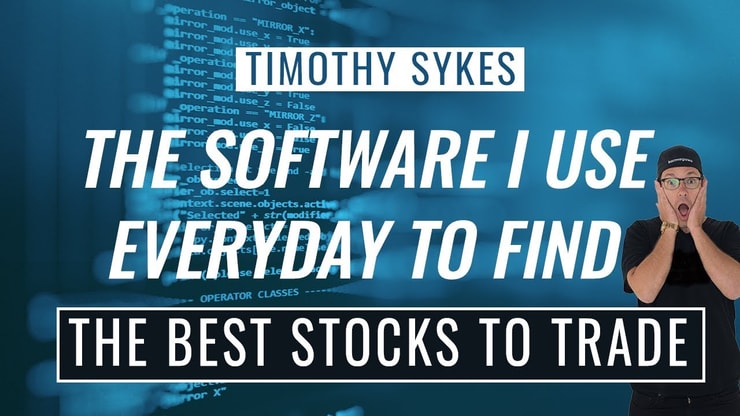Stock volume: let’s turn it up to eleven! Today we’ll talk about how you can use this measure to help improve your trading.
Listen up. As a trader, you should never rely on hunches or hot picks when you’re looking for stocks to trade. Instead, every trade should be the result of meticulous research and considering all sorts of variables.
I have certain criteria that I look for in every trade. I even have a scale to measure it — the Sykes Sliding Scale. Learn more about it here … That’s part of the Trader Checklist series. It’s a must-watch for new traders. (Hint: if you have a Profit.ly account, you can watch the original Trader Checklist guide here.)
Stock volume is only a piece of the puzzle when you’re figuring out trades, but every piece counts. Along with further research, it can help you make smarter trading decisions.
If you don’t understand how volume works, what it means, or why it matters, you’re probably not making the most intelligent trades you possibly can. My advice? Stop trading until you grasp this basic concept.
In this post, I’ll give you a sneak peek of what I teach to my Trading Challenge students about stock volume. Ready to learn how to use stock volume to improve your trading? Read on.
Psst: Wanna learn more vital trading terms? Check out this post.
Table of Contents
- 1 What Is Volume in the Stock Market? Definition
- 2 How Does a Stock’s Volume Affect a Stock’s Price?
- 3 What Is the Best Volume Indicator for Day Trading?
- 4 Stock Volume Spike Alerts — Trading Volume Analysis
- 5 Volume Trading Strategies — How to Use Volume to Improve Your Trading
- 6 Frequently Asked Questions About Stock Volume
- 7 What’s a Good Volume for Stocks?
- 8 How to Find the Volume of a Stock
- 9 Trading Challenge
- 10 The Final Word on Stock Volume
What Is Volume in the Stock Market? Definition
Let’s start at the beginning. What is stock volume?
It’s so easy…
Volume is the number of shares traded for the day. That’s it.
The higher the volume, the more shares being traded.
Go back and read that again if you didn’t get it. Everything else here will build on that basic definition.
Is a Stock’s Trade Volume Important?
Now you know what a stock’s volume is. But why is it important?
For one, you’ve got to remember this: when you’re entering a trade, it’s not just you buying shares. It’s a market. For every buyer, there’s got to be a seller and vice versa.
When you make a trade, you want to easily enter and exit positions without rocking the boat.
The more shares in movement, the easier the transaction will go through. The market keeps flowing without hiccups. That’s the beauty of a high-volume stock.
With a low-volume stock, on the other hand, you might have to wait before your order’s filled … And your order alone could jolt the stock’s price. And not in a good way.
Volume can affect the stock’s price and how quickly and easily you can get in and out of a trade.
When you need to get out, you likely want to sell NOW. You don’t want your order to be like a red flag alerting other traders it’s time for the price to go up or down.
That’s just one reason why volume matters.
Volume can also tell you that something’s going on with a stock that could cause price movement. Let’s look at an example.
Volume in the Stock Market — Example
Say that you’ve got stock Z. It’s trading regularly with a volume of about 5 million shares. But suddenly, today it’s trading 20 million shares.
Could this be a sign that something’s going on with the stock? Absolutely. It’s a strong sign that something got traders excited about this stock.
That doesn’t mean you should drop everything and dive into a trade. It’s more of a sign to watch the stock and do more research.
Even if you’re too late to get in on the trading action, you can still learn from the stock’s price action.
I can’t stress this enough: don’t let FOMO ruin your trading. Even if you miss a trade, you can still learn from how a pattern plays out. Patterns constantly play out in the stock market, and a lot of them will likely repeat again. Maybe not exactly … but close enough.
What Does High Volume Mean in the Stock Market?
A lot of penny stock traders have a black-and-white mentality when it comes to volume … High volume GOOD. Low volume BAD.
But there’s a huge gray area.
Volume depends on the stock, so it’s relative. For example, a stock like Amazon (NASDAQ: AMZN), even on its most boring day, will have far more volume than a penny stock. But that doesn’t mean that it’s a better stock to trade.
If a stock is moving and experiencing massively increased volume, that’s worth looking at.
As a penny stock trader, you want volatility. Volatility is where the huge price swings happen that can potentially earn you profits.
You can’t really compete with the pros who trade large-cap stocks. They have more experience, more information, more resources, and more knowledge than you. Sorry.
But the pros don’t really care about penny stocks. That can create opportunities for traders like you and me.
New to penny stocks? Access my FREE penny stock guide here.
How Does a Stock’s Volume Affect a Stock’s Price?
There’s a relationship between a stock’s volume and its price. But how does that work?
It’s not as simple as high volume equals higher price…
When a stock has high volume, it’s a sign that a lot of people are interested in the company. A lot of people are taking positions, whether long or short. Money’s flowing in and out of the company. Things are moving.
The more money that flows in and around a company, the higher the odds that the stock price could make a big price move — in either direction.
Volatility can be your friend … but also your foe.
When you’re on the right side of things, a big price move could potentially earn you more profits.
But if you’re on the wrong side, a big price move could make you lose big and fast. That’s why I always say you must follow rule #1: cut losses quickly. Don’t hold and hope.
Is High Volume Good for Stocks?
Once again, it’s not as easy as “high volume good, low volume bad.”
But there are some obvious benefits to high-volume stocks.
For one thing, stocks with high volume have greater liquidity than stocks with low volume.
Liquidity? What’s that?
Think about breakfast. You’ve got some toast and butter. If the butter’s cold and hard, it’s difficult to spread on the toast. But when you warm it up, it’s more liquid and spreads nice and smooth.
The stock market might not be a delicious fat, but the general concept of liquidity is the same. It’s easier to move things around when there’s liquidity.
Liquidity is key to easy entry and exit from a trade. It’s also important in that it keeps one individual order from moving a stock’s price too much.
With trading, you want to be like a ninja: quietly go in and leave without being noticed. You want to collect your profits and get out — no need for a big messy exit.
High volume can also give you a clue about a major catalyst that could move the stock’s price.
So if you see a distinct uptick in volume, look for news. Earnings winners, a big contract, Elon Musk smoking weed … It can all be connected to changes in stock volume.
But remember: volume is just one of many indicators. Don’t forget to do careful research and look for other indicators of a good trade.
Learn from my 20+ years of experience trading penny stocks. Subscribe to PennyStocking Silver for access to my 6,000+ videos.
What Does Low Stock Volume Mean?
Once again, low volume is relative. There are some stocks that will trade less than 10,000 shares a day … That can be dangerous territory.
I cover high-volume stocks more in this post. Quick recap: I think a stock with 500,000 to 1 million shares is acceptable for trading … if the conditions are right. But it’s super important to be vigilant about the trade. You want to be able to get out fast if it starts moving against you.
Another word of warning? If a stock has low volume and suddenly has big news, it’s a big red flag. If there’s no real reason, it could be a stock pump. Don’t trade blindly. Don’t follow alerts. Always do your own research.
What Is the Best Volume Indicator for Day Trading?
There are a few ways you can look at volume as a day trader. But to really get the full picture, stock charting software is a vital tool.
A lot of charting programs let you do things like set a moving average for volume. This lets you find out when there’s an exception. If you notice a big change in volume, it could be a sign that there’s something going on with a stock that’s worth watching.
Get a solid foundation on trading penny stocks by reading “The Complete Penny Stock Course” by my student Jamil. This book answers so many beginner’s questions. Read it three or four times. Refer to it as often as needed.
Stock Volume Spike Alerts — Trading Volume Analysis
Study, study, study.
Research, research, research.
You shouldn’t jump into any trade before you’ve done these things. But that doesn’t mean you have to be a slave to your laptop.
It’s no secret: I love the tools in StocksToTrade. I can use it to set various criteria to look at things like volume over different time periods or volume percent gainers. I can really get a better in-depth view of what’s going on with a stock.
Full disclosure: I was part of the team that created STT. I tried a ton of platforms over the years, but none of them matched my needs. We created the platform that really does everything a penny stock trader like me needs.
You can create scans to look for volume gainers or evaluate volume averages to see when there’s something notable going on with a stock. This can help you spot opportunities.
But remember: the screener can help with the numbers part … it won’t be responsible for the trade. Software can help you with trendlines, indicators, and moving averages, but you’ve got to make the final call.
Get my FREE weekly stock watchlist here. Learn how to use my watchlist here.
Volume Trading Strategies — How to Use Volume to Improve Your Trading
OK, so how about some specific tips and strategies? Let’s go.
High Volume Doesn’t Tell the Whole Story
High volume can be a sign that the stock has something interesting going on. But use it as a piece of the puzzle. It won’t tell you the full story.
Do more research to see if there’s any big news, patterns, or other indicators that could tell you this trade is a good idea.
Low Liquidity Is Not Your Friend
Remember: liquidity means stock shares are flowing. You need enough liquidity to ensure that you can get in and out of a trade easily.
Volume and Price Moves Should Be Linked
If a stock’s price is making big moves, the volume usually follows. Use volume as a means of confirming the price action. This is a way of supporting a stock that’s breaking out or through resistance.
If a stock rises or falls in a big way without a volume jump in kind, it could be a big red flag.
Volume Follows News Catalysts
A catalyst can bring a lot of attention to a stock, and often that equals price movement. So sometimes, if you see a rise in volume, it can alert you that this stock could make a big move soon.
Look for Volume Percent Gainers
Stock charting programs can help you look for specific criteria like volume percent gainers. This can help you find stocks that suddenly experience high demand and potentially big price movements too.
Frequently Asked Questions About Stock Volume
Got something you want to know about stock volume? Here are answers to some common questions.
What’s a Good Volume for Stocks?
I kind of hate this question because it’s relative. A ‘good’ volume will depend on the stock. But that said … for penny stocks it’s generally about finding the Goldilocks zone. You don’t want too much volume or too little.
Every trader has different criteria or opinions on the subject. But in general, I find 15–20 million shares per day too high.
Then again, a stock trading just 2,000–50,000 shares per day is too low. You’re not guaranteed to get your buy or sell order filled. It’s also really easy for a market maker to control a stock like this.
That leaves a lot of room in the middle. Which is part of why stock volume is only part of the picture. Trade smarter: look at a variety of factors and create a detailed trading plan.
How to Find the Volume of a Stock

This part’s easy. Pretty much every stock chart — whether you’re looking on Robinhood, Yahoo! Finance, or StocksToTrade — will show trading volume as one of the standard data points.
How Is Trade Volume Calculated?
Trade volume is calculated by determining how many shares change hands in a given time period.
To figure out the average trading volume, take the volume over a period of days, then divide the number by that number of days.
This can help you figure out what level of volume is usual or unusual for the stock.
What Is a Stock Volume Tracker?
Most charting software programs let you set a moving average or scan for volume. This can help you find anomalies and alert you to potential trading opportunities.
But remember: if you see a huge surge in volume after a long period of low volume, it’s not always a good thing. Be very wary of potential pump schemes! Don’t be left holding the bag.
Trading Challenge
If you really want to make smart trades, you need to be obsessed with the stock market and how it works. You need to really love learning the details of what makes stocks move.
Sound like fun? If you’re dedicated to becoming a knowledgeable trader, consider applying for my Trading Challenge.
I don’t want just any student. That’s why you have to apply rather than just signing up. I want to weed out lazy idiots who just want hot stock picks or think they’ll get rich quick.
I take pride in what I do. I teach based on my 20+ years in the stock market. I haven’t learned everything, but I have learned a lot. And I’ve made millions.* I want to share what I’ve learned with you so you don’t have to learn everything like I did — the hard way.
As a student, you’ll have access to tons of video lessons, interactive webinars, and trading commentary … not just from me, but from my top students, too.
It’s not a get-rich-quick scheme. It’s a long-term prospect. But I believe if you build the right foundation it IS possible to become a smart, adaptable, self-sufficient trader.
Why do I only have a few multi-millionaire students? Watch: https://t.co/WNTXXWAoBR well, it takes time/dedication, no laziness allowed!
— Timothy Sykes (@timothysykes) February 15, 2020
Every year, I go back to a $12K trading account. That’s exactly where I started decades ago. I trade with a small account so that I can teach my students the process.
This year, I’m trading with a bigger account too. I want to continue to serve my students who trade bigger now. It hopefully will also allow me to donate more through my Karmagawa charity.
I document every single trade … I’m totally transparent!
My Trading Challenge isn’t the easiest program. You gotta work your butt off. But it can be worth it. Like when my student Mark Croock has a week like this.
Ready to get started? Apply today.
*My trading results are not typical. I’ve spent years developing exceptional skills and knowledge. Always remember trading is risky. Do your due diligence. Never risk more than you can afford.
The Final Word on Stock Volume
As a trader, you need to piece together as many pieces of information as possible to make a case for your trade. Looking at stock volume can be part of that process.
There’s never a sure thing in the stock market. That’s why it’s so important to be vigilant about doing research on a given stock. It’s also why you have to build your knowledge account before you start building your monetary account.
Learn everything you can to start making smarter trading decisions. Then keep learning. Your market education never ends because the market changes and evolves all the time.
Ready to learn the skills you need to make smart, educated trades? Apply for my Trading Challenge today!
Tell me what you think? How often do you use volume as part of your stock research? Be honest — leave a comment!






Leave a reply